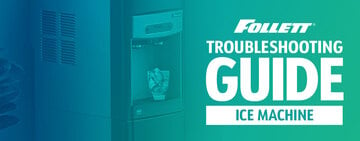
Ice machines serve important functions in restaurants, bars, hotels, and a variety of other business settings. Even though ice makers are an important piece of kitchen equipment, many restaurant or business owners neglect to clean them regularly. This article will take you through a detailed, step-by-step explanation of how to clean an ice machine, ensuring your equipment is safe for your customers.
Shop All Ice Machine Cleaners and SanitizersIce Machine Cleaning Video
Watch the video below to learn how to clean a commercial ice machine. We've also included a detailed list of steps to walk you through the process.
How to Clean an Ice Maker
Ice makers' maintenance requirements will vary from vendor to vendor, but most ice machines follow a similar overall process. Please consult with your machine's manual for the appropriate procedure, but here are some general steps to clean most ice makers.

- Remove ice from bin or dispenser: All ice must be removed during the cleaning and sanitizing cycles. This can be accomplished through two different methods. You can either press the power switch at the end of the harvest cycle after ice falls from the evaporators or press the power switch and allow the ice to completely melt.
- Press the “clean” or “wash” button: Once you’ve pushed this button, water will flow through the water dump valve and down the drain. Wait until the water trough refills and the display indicates to add chemicals. This typically takes at least 1 minute.
- Add cleaner: Be sure to use the recommended amount of ice machine cleaner per your manual.
- Wait until the clean cycle is complete: The cleaning cycle typically lasts at least 20 minutes. Once it is complete, disconnect power to the ice machine. If power can be shut off to the dispenser, it's important to do that as well.
- Remove internal components: Before cleaning, take any internal components out of your ice machine. For safe and proper removal, refer to your machine's manual. Once all parts have been removed, continue to the next step.
- Mix cleaning solution: Dilute your mix of cleaning solution with lukewarm water. Refer to your machine's manual for an appropriate amount of solution. A general water-to-cleaner ratio is 1 gallon of water to 16 ounces of cleaner. Depending on the amount of mineral buildup, you may need to use more cleaner.
- Clean removed components: Use half of the water and cleaner mixture to clean all components and parts you've removed. Most solutions will start to foam once they come in contact with lime, scale, and mineral deposits. Once the foaming stops, use a soft-bristle nylon brush, sponge, or cloth to carefully clean all parts and then rinse with clean water.
- Clean foodzone surfaces: Use the other half of the water and cleaner mixture to clean all foodzone surfaces of the ice machine and bin or dispenser. Use a nylon brush or cloth to thoroughly clean the following ice machine areas: side walls, base (area above the trough), evaporator plastic parts (top, bottom, sides), and the bin or dispenser.
- Rinse: Make sure to rinse all areas with clean water. This will help remove chemicals to prevent ice from becoming contaminated.
How to Clean the Exterior of an Ice Maker
As you clean your ice maker, it’s important to focus not just on the machine itself, but on the area surrounding it. Failure to maintain a clean workspace directly surrounding your ice machine can cause dirt and grease to build up faster and contribute to an unhealthy working environment. Below, we’ve included tips for how to clean the outside of your commercial ice maker.
- Focus on immediate surroundings: Clean the area around the ice machine as often as necessary. Doing so helps to ensure your ice machine operates cleanly and efficiently.
- Use the correct cleaning materials: Wipe surfaces down with a damp cloth rinsed in water to remove dust and dirt from the outside of the ice machine. Never use an abrasive pad or brush.
- Clean any grease that remains: If a greasy residue remains after cleaning, use a damp cloth rinsed in a mild dish soap and water solution. See your machine's manual for restrictions. Do not use chlorinated, citrus-based, or abrasive cleaners on exterior panels and plastic trim.
How to Sanitize an Ice Machine
To truly maintain a safe ice machine, remember to sanitize the machine after cleaning it. While cleaning a surface removes any dirt or germs that you can see, sanitizing it helps to reduce the number of pathogens to a safe level. Here are the steps you need to follow to sanitize your ice maker once you have removed any mold or buildup from your machine and its components.

- Prepare your sanitizer: Dilute your ice machine sanitizer by mixing it with lukewarm water. Refer to your machine's manual for an appropriate amount of solution. A general water-to-cleaner ratio is 3 gallons of water to 2 ounces of sanitizer.
- Sanitize removed components: Use half of the water and sanitizer mixture to sanitize all components and parts you've removed from the machine. You can use a spray bottle to liberally apply the solution to all surfaces of the removed parts, or you can soak the removed parts in the solution. It’s essential that you don’t rinse parts with water after sanitizing.
- Sanitize remaining surfaces: Use the other half of the water and sanitizer mixture to clean all foodzone surfaces of the ice machine, bin, and dispenser. Make sure to sanitize the following areas: side walls, base (area above the trough), evaporator plastic parts (top, bottom, sides), and the bin or dispenser.
- Replace sanitized parts: Once they’ve been sanitized, place the removed parts back onto the ice machine.
- Wait 20 minutes: By waiting, you allow the sanitizer to properly disinfect your ice machine.
- Restore power: Once you’re finished waiting, reconnect the ice machine to power. This can be done by pressing your unit's "clean" or "wash" button.
- Allow water troughs to refill: It’s important to wait until your display indicates the troughs have been refilled before adding your chemicals. Once this has been done, you’re free to add the proper amount of sanitizer to the water trough.
- Enable automatic ice making: Set your machine to automatically start making ice after the sanitizing cycle is complete. This will typically take at least 20 minutes.
- Observe: Upon completion, it's recommended to observe two cycles and monitor the freeze and harvest cycle times. Make sure you throw out the first batch of ice made after cleaning and sanitizing.
How to Clean an Ice Machine Condenser and Its Filter
Like the other components of your ice machine, the condenser should be cleaned once every six months. Follow these steps to clean the condenser of your ice maker:
- Turn the power off: Disconnect power to the ice machine head section (and the remote condensing unit, if applicable).
- Check for dirt: Shine a flashlight through the condenser to check for dirt between the fins.
- Clean the filter: Blow compressed air through the condenser to remove any dirt in the filter. You can also rinse it with water from the inside out.
- Double-check: After you’ve gone through the process of identifying and removing dirt, check to see if any remains. If it does, we recommend that you contact a service agent.
To clean your machine's filter, simply rinse it with mild soap and water.
Why It's Important to Clean an Ice Maker

The FDA defines ice as a food, which means it must be handled and cared for in the same manner as other food products. Any part of your ice machine that has contact with water can develop scale, slime, or mold at any time, which will contaminate your ice and potentially harm your customers.
How Often Should You Clean Your Ice Machine?
Your ice machine should be cleaned and sanitized at least once every six months for efficient operation. First, you must perform the cleaning procedure to remove lime, scale, and mineral deposits, followed by the sanitizing procedure to disinfect the unit and remove algae and slime.
Reasons to Clean Your Ice Machine Frequently
- Avoid scale buildup on evaporator plates
- Prevent impeded heat transfer
- Keep harvest times short
- Help your machine maintain full capacity
- Defend against costly repairs
Signs You Need to Clean Your Ice Maker
Since germs and dirt accumulate over time, it may be difficult to identify when your machine needs to be cleaned. If you experience some of the following issues, it may be time to clean your ice machine:
- Ice machine does not release ice or is slow to harvest
- Ice machine does not cycle into harvest mode
- Ice quality is poor (soft or not clear)
- Ice produces an odor
- Ice machine produces shallow or incomplete cubes
- Low ice capacity
Ice Machine Cleaning Tips
If you’re inexperienced in cleaning kitchen appliances, you may find yourself lost when it comes to efficiently cleaning them. Below, we’ve listed some general tips to consider before cleaning your ice machine.
- Use the correct cleaning products: Some manufacturers require specific or approved cleaner and sanitizer solutions to be used with their machines.
- Follow instructions: It's essential that you follow the directions in your ice maker's manual when cleaning. The steps above are general guidelines that apply to most machines.
- Keep chemicals separated: For safety reasons, do not mix the cleaner and sanitizer solutions. Doing so may result in a chemical reaction, which can be hazardous.
- Use protective equipment: Wear rubber gloves and protective safety glasses when handling cleaner and sanitizer solutions.
- Monitor water quality: Check your establishment's water quality if your machine requires maintenance more and more frequently. Water treatment or a new water cartridge may be necessary.
- Manage controls: Do not leave the control switch in a service position for an extended period of time when the water tank is empty during cleaning. This could damage the water pump.
- Know your equipment: Nugget and flake machines typically have more moving parts that require additional attention.
By cleaning and sanitizing your ice machine, you'll be able to maintain your unit's efficiency, prevent increased energy costs, and make clean and safe ice that is ready to use. Remember to clean and sanitize at least once every six months, and don't forget to refer to your ice machine's manual for special instructions.





